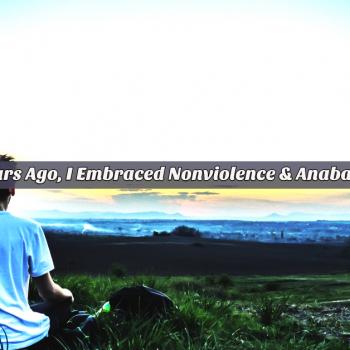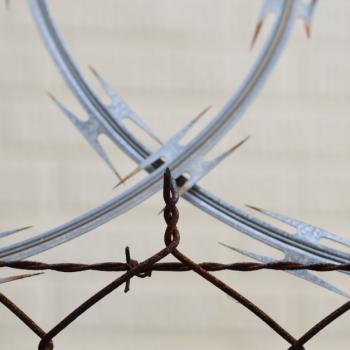The following is part of a fairly long series on the theology and practice of nonviolence. If you would like to read all of the posts, you can do so here.
————————————–
“What if…” #1
Without fail, there are two “what if” scenarios that always emerge when having this discussion with American friends. The first of these is: What if a Hitler-like dictator emerges? The conversation usually goes in the direction of claiming that there was no other option than to fight in WWII to stop the genocide of millions of people. It may be true that by the time the United States intervened, that there was no other foreseeable path but war. But that is exactly the problem with the question. It assumes that the war is well under way and that we peacemakers now have to go and turn the hearts of the Nazi’s through nonviolent subversion. The problem is that WWII is a product of the myths we just dealt with. Imagine if all Christians in Germany would have “turned the other cheek” and refused to take up arms? Nazism would likely have come to nothing! Robert Brimlow, in What About Hitler, takes this a bit further:
If the question is asking how a pacifistic church should have responded to the horrors of the Holocaust, the answer surely lies in being a peacemaking church long before the Halocaust ever began. The church should have preached and lived a love of the Jews for many centuries before the twentieth; the church should have formed Christians into the kind of people who do not kill Jews, or homosexuals, or gypsies, or communists, or other Christians, or Nazis, or whoever else was victimized by the war. The church should have lived and taught in such a way that the First World War would have been incomprehensible in a largely Christian Europe… The failure of the church and of Christians to be peacemakers in 1942 is horrible precisely because it was a result and culmination of centuries of failure.[1]
“What if…” #2
The second “what if” question is no easier than the first, and gets quite personal for someone espousing nonviolence: What if your spouse or child is attacked? This is where we need to go back to our main Matthew text for a moment (to understand this part of the argument, you have to read posts: 2, 3, & 4). Remember that Jesus instructs his followers to not “use violence to resist evil!” Then, what follows are three examples of how to resist both passivity and violence, through unlocking the imagination and seeking a “third way.” The importance of each of the solutions that Jesus offers is better understood in an honor-shame culture. Each time, Jesus invites followers to restore their own honor and in doing so to shame the oppressor—perhaps, in such a way that leads to repentance. What I am getting at is that in each of these situations, not only is violence resisted, but full human dignity is being restored. Clearly, a central reason why violence is wrong in this textual context is that it is dehumanizing.
To answer the question at hand I want to reflect on the idea of dehumanization as being the definition of violence. This certainly is not a stretch based on the background of the passage. Therefore, in certain emergency scenarios, such as rescuing a loved one, the use of restraint or even force is not out of the question. If an attacker was dehumanizing my wife or child, my hope is that I would discover a “third way” out of the situation that may even include sacrificing myself for their sake. But, it is also possible that things would move so quickly that the use of force may be the only option. So, perhaps I would pull the person off of my loved one, allowing the chance to flee for safety. If need be, I suppose that tackling the attacker may be a borderline option as well. What is not an option is passive inaction. This is obviously a circumstantial approach with several shades of “gray.” Any restraint must always be within the parameters of avoiding anything that would treat a person as less than a human created in God’s image. Hitting, kicking, or the use of weapons have taken restraint into the realm of violence and out of the realm of loving our enemies.
Finally, let me be clear: the above is what I HOPE I WOULD DO, NOT WHAT I ‘WOULD’ DO. By God’s grace I desire that in all situations I would refuse violence, but the reality is that the lesser-evil-kind-of-sin of resorting to violence in a situation like the one I just outlined may be what would actually happen. If I resorted to violence, it would not be justified by the New Testament witness and it would not be the creative “third way” of Jesus. So, I pray that I am never in such a situation, but if I am, may God’s grace be with me; and may the Holy Spirit give me words and actions to catch the attacker off guard without resorting to the use of the sword.
[1]. Robert W. Brimlow, What about Hitler?: Wrestling with Jesus’s call to Nonviolence in an Evil World (Grand Rapids, Mich.: Brazos Press, 2006), 168-69.












